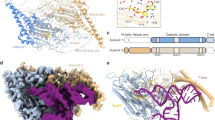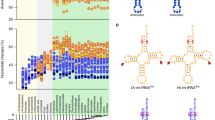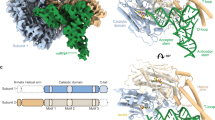Abstract
The genetic code is not frozen but still evolving, which can result in the acquisition of 'dialectal' codons that deviate from the universal genetic code. RNA modifications in the anticodon region of tRNAs play a critical role in establishing such non-universal genetic codes. In echinoderm mitochondria, the AAA codon specifies asparagine instead of lysine. By analyzing mitochondrial (mt-) tRNALys isolated from the sea urchin (Mesocentrotus nudus), we discovered a novel modified nucleoside, hydroxy-N6-threonylcarbamoyladenosine (ht6A), 3′ adjacent to the anticodon (position 37). Biochemical analysis revealed that ht6A37 has the ability to prevent mt-tRNALys from misreading AAA as lysine, thereby indicating that hydroxylation of N6-threonylcarbamoyladenosine (t6A) contributes to the establishment of the non-universal genetic code in echinoderm mitochondria.
This is a preview of subscription content, access via your institution
Access options
Access Nature and 54 other Nature Portfolio journals
Get Nature+, our best-value online-access subscription
$29.99 / 30 days
cancel any time
Subscribe to this journal
Receive 12 print issues and online access
$189.00 per year
only $15.75 per issue
Buy this article
- Purchase on Springer Link
- Instant access to full article PDF
Prices may be subject to local taxes which are calculated during checkout



Similar content being viewed by others
References
Crick, F.H. The origin of the genetic code. J. Mol. Biol. 38, 367–379 (1968).
Barrell, B.G., Bankier, A.T. & Drouin, J. A different genetic code in human mitochondria. Nature 282, 189–194 (1979).
Kollmar, M. & Mühlhausen, S. Nuclear codon reassignments in the genomics era and mechanisms behind their evolution. BioEssays 39 (2017).
Watanabe, K. & Yokobori, S. tRNA modification and genetic code variations in animal mitochondria. J. Nucleic Acids 2011, 623095 (2011).
Suzuki, T., Nagao, A. & Suzuki, T. Human mitochondrial tRNAs: biogenesis, function, structural aspects, and diseases. Annu. Rev. Genet. 45, 299–329 (2011).
Nakano, S. et al. NSUN3 methylase initiates 5-formylcytidine biogenesis in human mitochondrial tRNA(Met). Nat. Chem. Biol. 12, 546–551 (2016).
Takemoto, C. et al. Unconventional decoding of the AUA codon as methionine by mitochondrial tRNAMet with the anticodon f5CAU as revealed with a mitochondrial in vitro translation system. Nucleic Acids Res. 37, 1616–1627 (2009).
Watanabe, Y. et al. Primary and higher order structures of nematode (Ascaris suum) mitochondrial tRNAs lacking either the T or D stem. J. Biol. Chem. 269, 22902–22906 (1994).
Tomita, K. et al. Codon reading patterns in Drosophila melanogaster mitochondria based on their tRNA sequences: a unique wobble rule in animal mitochondria. Nucleic Acids Res. 27, 4291–4297 (1999).
Kawarada, L. et al. ALKBH1 is an RNA dioxygenase responsible for cytoplasmic and mitochondrial tRNA modifications. Nucleic Acids Res. 45, 7401–7415 (2017).
Ohira, T. et al. Decoding mechanism of non-universal genetic codes in Loligo bleekeri mitochondria. J. Biol. Chem. 288, 7645–7652 (2013).
Yokobori, S., Suzuki, T. & Watanabe, K. Genetic code variations in mitochondria: tRNA as a major determinant of genetic code plasticity. J. Mol. Evol. 53, 314–326 (2001).
Tomita, K., Ueda, T. & Watanabe, K. The presence of pseudouridine in the anticodon alters the genetic code: a possible mechanism for assignment of the AAA lysine codon as asparagine in echinoderm mitochondria. Nucleic Acids Res. 27, 1683–1689 (1999).
Morris, R.C., Brown, K.G. & Elliott, M.S. The effect of queuosine on tRNA structure and function. J. Biomol. Struct. Dyn. 16, 757–774 (1999).
Stern, L. & Schulman, L.H. The role of the minor base N4-acetylcytidine in the function of the Escherichia coli noninitiator methionine transfer RNA. J. Biol. Chem. 253, 6132–6139 (1978).
Hirsh, D. Tryptophan tRNA of Escherichia coli. Nature 228, 57 (1970).
Schmeing, T.M., Voorhees, R.M., Kelley, A.C. & Ramakrishnan, V. How mutations in tRNA distant from the anticodon affect the fidelity of decoding. Nat. Struct. Mol. Biol. 18, 432–436 (2011).
Canaday, J., Dirheimer, G. & Martin, R.P. Yeast mitochondrial methionine initiator tRNA: characterization and nucleotide sequence. Nucleic Acids Res. 8, 1445–1457 (1980).
Dubin, D.T. & HsuChen, C.C. Sequence and structure of a methionine transfer RNA from mosquito mitochondria. Nucleic Acids Res. 12, 4185–4189 (1984).
Miyauchi, K., Ohara, T. & Suzuki, T. Automated parallel isolation of multiple species of non-coding RNAs by the reciprocal circulating chromatography method. Nucleic Acids Res. 35, e24 (2007).
Suzuki, T., Ikeuchi, Y., Noma, A., Suzuki, T. & Sakaguchi, Y. Mass spectrometric identification and characterization of RNA-modifying enzymes. Methods Enzymol. 425, 211–229 (2007).
Mengel-Jørgensen, J. & Kirpekar, F. Detection of pseudouridine and other modifications in tRNA by cyanoethylation and MALDI mass spectrometry. Nucleic Acids Res. 30, e135 (2002).
Björk, G.R. & Hagervall, T.G. Transfer RNA modification: presence, synthesis, and function. Ecosal Plus http://dx.doi.org/10.1128/ecosalplus.ESP-0007-2013 (2014).
Kimura-Harada, F., Von Minden, D.L., McCloskey, J.A. & Nishimura, S. N-((9- D-ribofuranosylpurin-6-yl)-N-methylcarbamoyl) threonine, a modified nucleoside isolated from Escherichia coli threonine transfer ribonucleic acid. Biochemistry 11, 3910–3915 (1972).
Miyauchi, K., Kimura, S. & Suzuki, T. A cyclic form of N6-threonylcarbamoyladenosine as a widely distributed tRNA hypermodification. Nat. Chem. Biol. 9, 105–111 (2013).
Matuszewski, M. et al. A hydantoin isoform of cyclic N6-threonylcarbamoyladenosine (ct6A) is present in tRNAs. Nucleic Acids Res. 45, 2137–2149 (2017).
Yamaizumi, Z. et al. Structure elucidation by high-resolution mass-spectrometry of a highly modified nucleoside from mammalian transfer-RNA. N-[(9-b-D-Ribofuranosyl-2-Methylthiopurin-6-yl)Carbamoyl]Threonine. J. Am. Chem. Soc. 101, 2224–2225 (1979).
Kang, B.I. et al. Identification of 2-methylthio cyclic N6-threonylcarbamoyladenosine (ms2ct6A) as a novel RNA modification at position 37 of tRNAs. Nucleic Acids Res. 45, 2124–2136 (2017).
Osawa, S. Evolution of the Genetic Code (Oxford University Press, Oxford, 1995).
Sengupta, S. & Higgs, P.G. A unified model of codon reassignment in alternative genetic codes. Genetics 170, 831–840 (2005).
Jung, G., Choi, H.J., Pae, S. & Lee, Y.H. Complete mitochondrial genome of sea urchin: Mesocentrotus nudus (Strongylocentrotidae, Echinoida). Mitochondrial DNA 24, 466–468 (2013).
Kiryu, H. et al. A detailed investigation of accessibilities around target sites of siRNAs and miRNAs. Bioinformatics 27, 1788–1797 (2011).
Ohira, T. & Suzuki, T. Precursors of tRNAs are stabilized by methylguanosine cap structures. Nat. Chem. Biol. 12, 648–655 (2016).
Sakaguchi, Y., Miyauchi, K., Kang, B.I. & Suzuki, T. Nucleoside analysis by hydrophilic interaction liquid chromatography coupled with mass spectrometry. Methods Enzymol. 560, 19–28 (2015).
Liu, J.Q. et al. Gene cloning, biochemical characterization and physiological role of a thermostable low-specificity L-threonine aldolase from Escherichia coli. Eur. J. Biochem. 255, 220–226 (1998).
Kim, J., Kershner, J.P., Novikov, Y., Shoemaker, R.K. & Copley, S.D. Three serendipitous pathways in E. coli can bypass a block in pyridoxal-5′-phosphate synthesis. Mol. Syst. Biol. 6, 436 (2010).
Thiaville, J.J. et al. Members of a novel kinase family (DUF1537) can recycle toxic intermediates into an essential metabolite. ACS Chem. Biol. 11, 2304–2311 (2016).
Sampson, J.R. & Uhlenbeck, O.C. Biochemical and physical characterization of an unmodified yeast phenylalanine transfer RNA transcribed in vitro. Proc. Natl. Acad. Sci. USA 85, 1033–1037 (1988).
Taniguchi, T. et al. Decoding system for the AUA codon by tRNAIle with the UAU anticodon in Mycoplasma mobile. Nucleic Acids Res. 41, 2621–2631 (2013).
Ogle, J.M., Murphy, F.V., Tarry, M.J. & Ramakrishnan, V. Selection of tRNA by the ribosome requires a transition from an open to a closed form. Cell 111, 721–732 (2002).
Acknowledgements
We are grateful to the Suzuki laboratory members for many fruitful discussions and technical advice. This work was supported by Grants-in-Aid for Scientific Research on Priority Areas from the Ministry of Education, Science, Sports, and Culture of Japan (Japan Society for the Promotion of Science grant nos. 26113003, 26220205 and 24370093 to T.S., 26116003 to A.N., 24370093 to S.Y. and 24370093 to K.W.).
Author information
Authors and Affiliations
Contributions
A.N. and M.O. mainly performed the series of experiments. K.M. assisted with the biochemical work. S.Y., A.Y., and K.W. prepared RNA specimens. All authors discussed the results. T.S. and A.N. wrote the paper. T.S. designed and supervised all of the work.
Corresponding author
Ethics declarations
Competing interests
The authors declare no competing financial interests.
Integrated supplementary information
Supplementary Figure 1 Isolation of mt-tRNAs and RNA-MS analysis of mt-tRNAAsn from M. nudus
(a) M. nudus mt-tRNAs were isolated by RCC and resolved by 10% denaturing PAGE. The gel was stained with SYBR Gold (Invitrogen) and visualized using an FLA-7000 image analyzer (Fujifilm). The tRNAs as indicated by arrows were cut out of the gel and purified.
(b) Top panel: base peak chromatogram (BPC) of RNase T1-digested fragments; second and third panel: extracted ion chromatograms (XIC) for the negative ions of the anticodon-containing fragments as indicated. Molecular mass of each fragment numbered on the BPC is listed in Supplementary Table 1. Bottom panel shows the CID spectrum of the cyanoethylated anticodon-containing fragment. The c- and y-series product ions are indicated on the CID spectrum and assigned on the corresponding sequence.
(c) Secondary structure of M. nudus mt-tRNAAsn with post-transcriptional modifications. The numbering system of tRNA is based on the tRNA database (Juhling, F. et al., Nucleic Acids Res. 37, D159-62, 2009). m1A: 1-methyladenosine, m2,2G: N2, N2-dimethylguanosine, Ψ: pseudouridine, and t6A: N6-threonylcarbamoyladenosine.
Supplementary Figure 2 RNA-MS analysis of M. nudus mt-tRNALys
XICs of the anticodon-containing fragments with N428 at position 37 (upper panel), t6A37 (lower panel). Sequence, m/z values, and charge state of each fragment are indicated on the right side. The frequency of each modification was calculated from the ratio of the peak areas of the two fragments.
Supplementary Figure 3 CID spectrum of t6A base
The t6A base was generated by in-source fragmentation of t6A nucleoside in individual E. coli tRNAThr4. The product ions are assigned on the chemical structure of the t6A base. The internal fragment of the threonine moiety is indicated by a dotted line.
Supplementary Figure 4 Enzymatic synthesis of Thr and 4-hydroxythreonine
LtaE catalyzes an aldol condensation reaction of acetaldehyde and glycine to synthesize Thr utilizing pyridoxal phosphate (PLP) as a cofactor. LtaE catalyzes the same reaction with glycolaldehyde and glycine to form 4-hydroxythreonine.
Supplementary Figure 5 RPC-LC/MS co-injection analysis of the synthetic ht6A and natural N428
XICs of synthetic ht6A (left panel), nucleosides of M. nudus mt-tRNALys (middle panel), and co-injection of both samples (right panel). Lower panels show XICs of m1A (m/z 298) as controls.
Supplementary Figure 6 CID analysis of the synthetic ht6A
CID spectra of ht6A nucleoside (upper panel) and its base ion (lower panel). ht6A base (BH2+) was generated by in-source fragmentation of ht6A nucleoside of E. coli tRNALys transcript bearing ht6A37. The product ions are assigned in the corresponding chemical structures. The internal fragment of the methyl threonine moiety is indicated by a dotted line.
Supplementary information
Supplementary Text and Figures
Supplementary Figures 1–6 and Supplementary Table 2 (PDF 831 kb)
Supplementary Table 1
RNase T1-digested fragments of M. nudus mt-tRNAs detected by RNA-MS (XLSX 11 kb)
Exact molecular mass (Da), and observed and calculated monoisotopic m/z value with its charge state for each fragment are listed.
Rights and permissions
About this article
Cite this article
Nagao, A., Ohara, M., Miyauchi, K. et al. Hydroxylation of a conserved tRNA modification establishes non-universal genetic code in echinoderm mitochondria. Nat Struct Mol Biol 24, 778–782 (2017). https://doi.org/10.1038/nsmb.3449
Received:
Accepted:
Published:
Issue Date:
DOI: https://doi.org/10.1038/nsmb.3449
This article is cited by
-
Crystal structures and insights into precursor tRNA 5’-end processing by prokaryotic minimal protein-only RNase P
Nature Communications (2022)
-
The expanding world of tRNA modifications and their disease relevance
Nature Reviews Molecular Cell Biology (2021)
-
Dual pathways of tRNA hydroxylation ensure efficient translation by expanding decoding capability
Nature Communications (2019)
-
Acetate-dependent tRNA acetylation required for decoding fidelity in protein synthesis
Nature Chemical Biology (2018)



